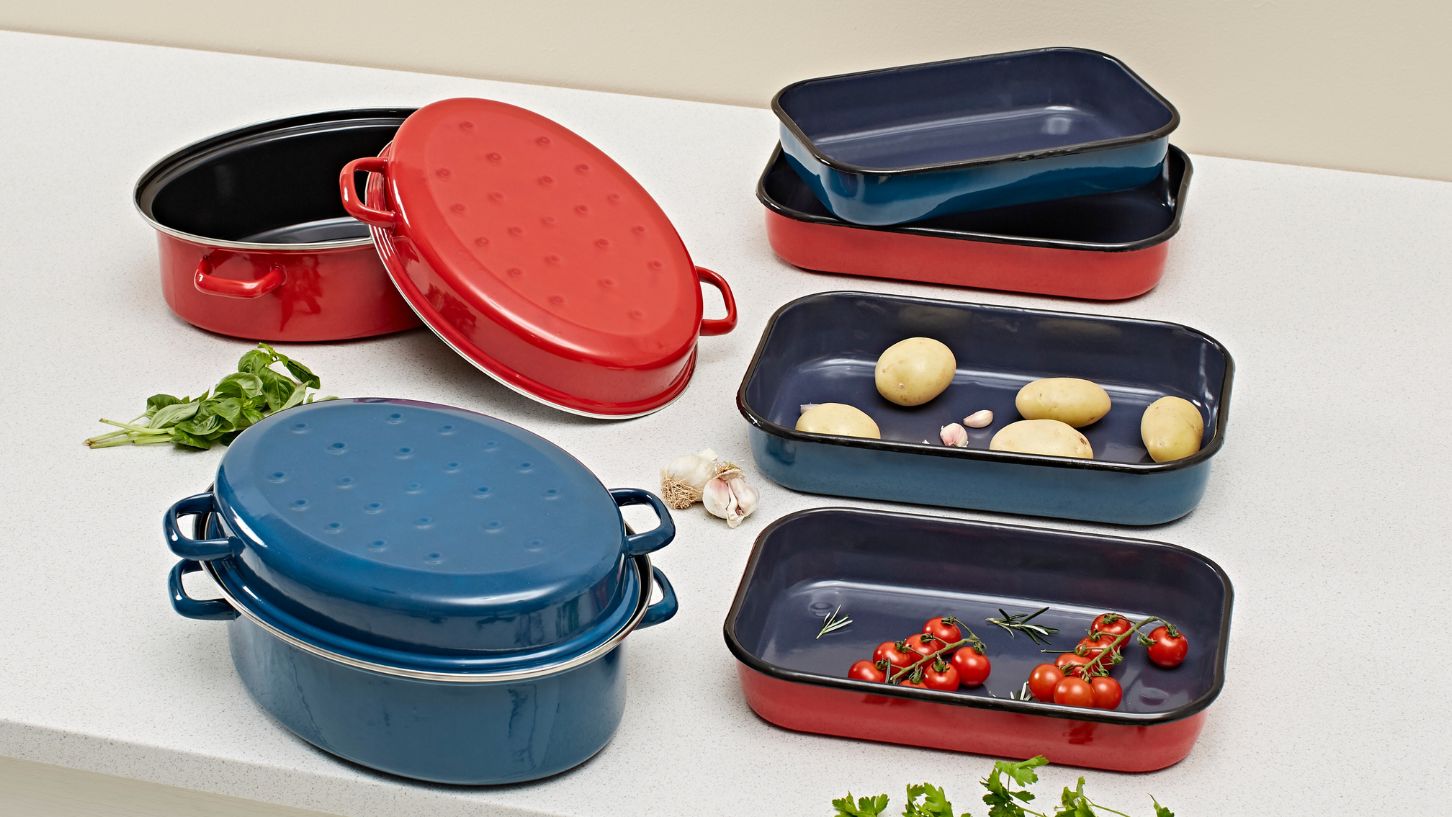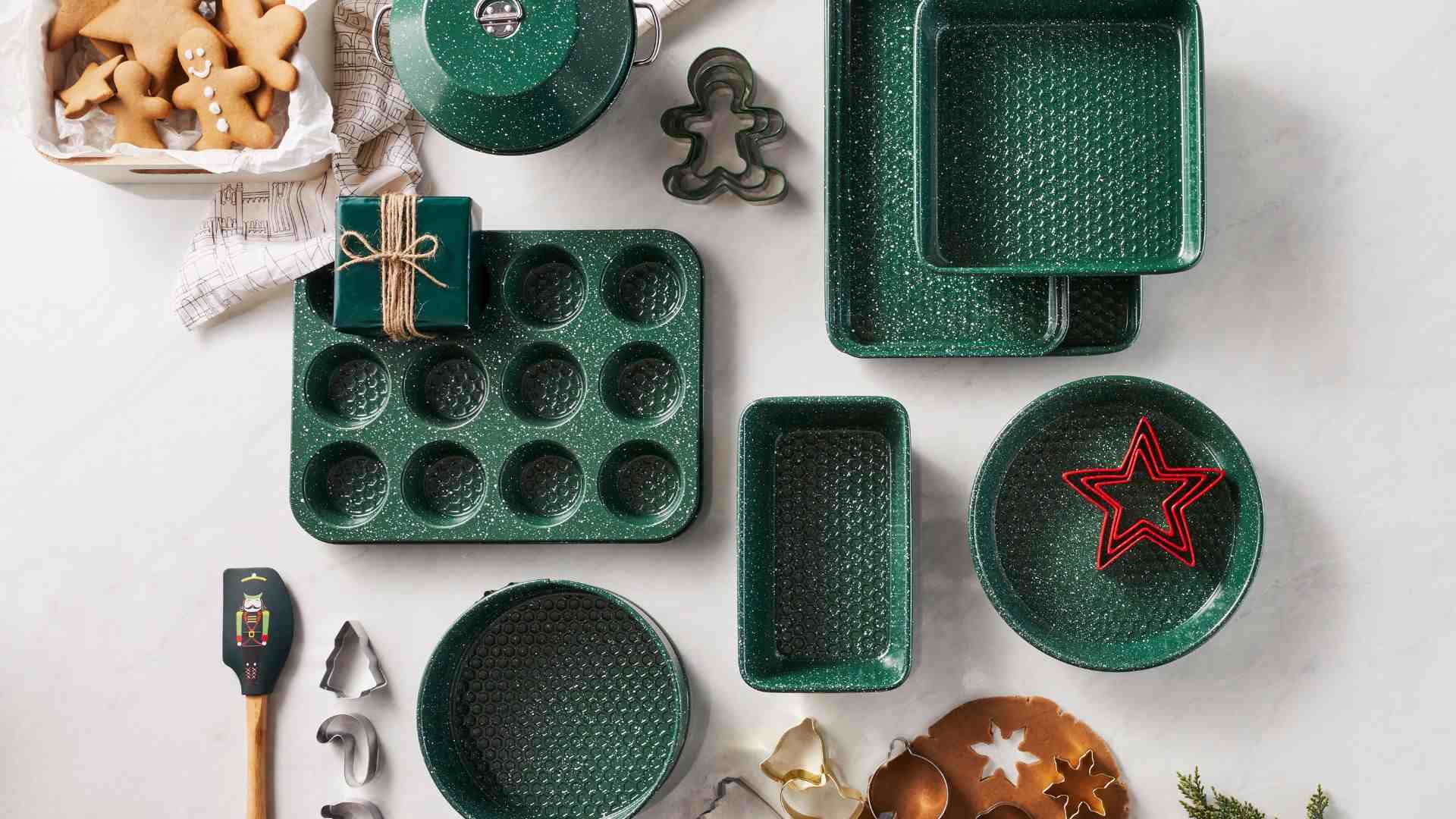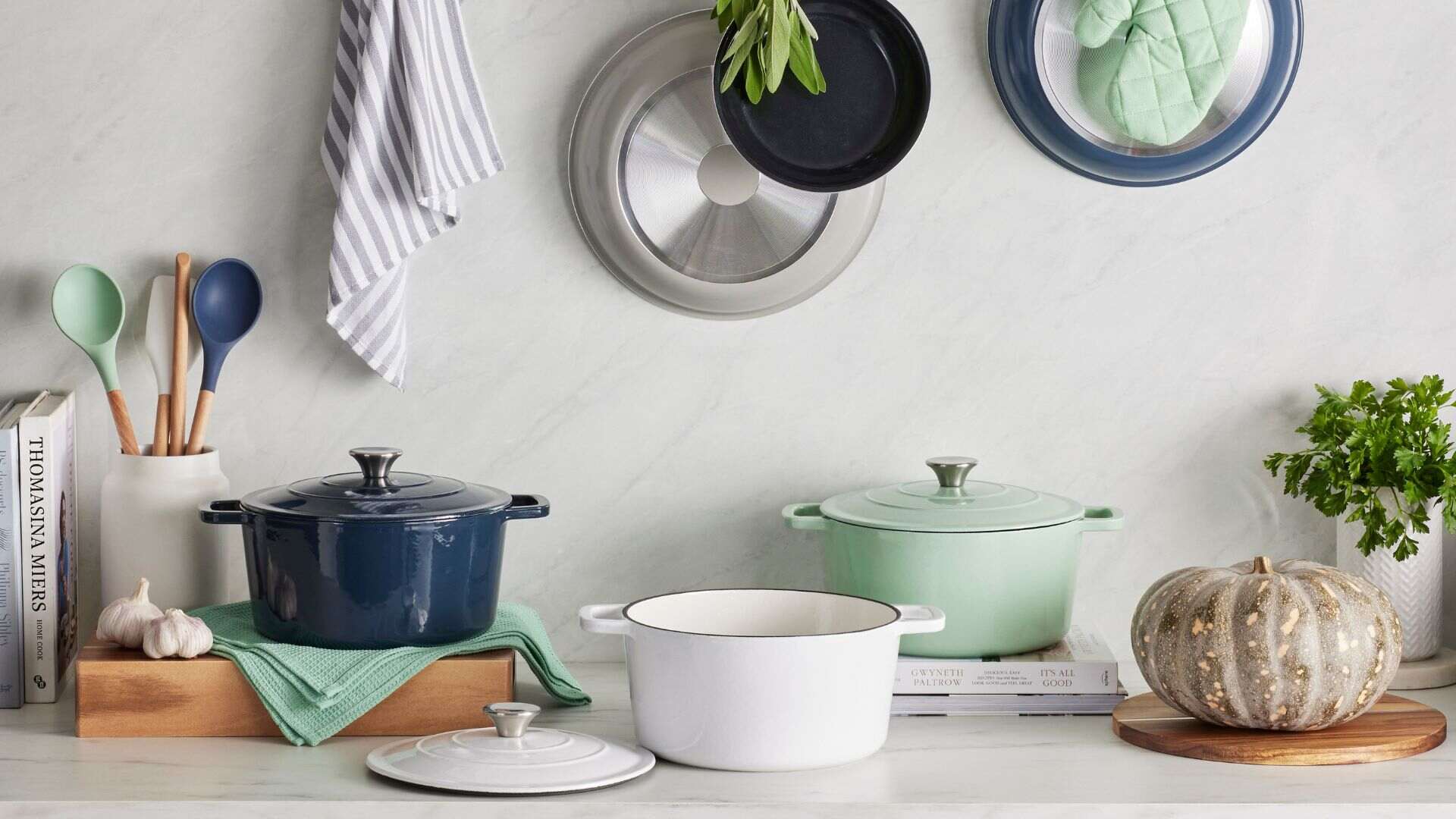| Your browser is not supported. | ||
|
Please browse our site using any of the following options:
| ||
BAKEWARE 101: YOUR COMPLETE OVENWARE BUYING GUIDE
Cooking and baking are not just about preparing food. Instead, they tie into creating memories and experiences that evoke joy and nostalgia. And what better way to do that than with the right tools and utensils? Combining the right bakeware sets, cookware sets, stove-to-oven cookware, and pots and pans can transform your cooking and baking experience in the kitchen.
In this guide, we'll take you through everything you need to know to make an informed decision when purchasing ovenware. We'll cover everything from the benefits of using ovenware to the different types of ovenware available. You'll also learn about the factors to consider when choosing the size and shape of your ovenware and the features you should look out for, such as non-stick coatings and oven-safe temperatures. As a bonus, you'll get tips on how to care for and maintain your items, so you can enjoy using them for years to come. So whether you're a novice or an experienced cook, this guide has something for everyone. Get ready to take your cooking and baking game to the next level by choosing the best ovenware and bakeware for your needs, with help from Harris Scarfe!
Quick Links:
- What Oven Dishes Do I Need?
- Best Materials For Ovenware
- Bakeware & Ovenware - Different Types, Sizes & Shapes
- Most Popular Types Of Oven Bakeware
- Best Rated Ovenware & Bakeware Brands
- Features To Look For When Choosing Bakeware
- Care & Maintenance
- Frequently Asked Questions
- You May Also Like
Understanding Your Kitchen Arsenal: What Oven Dishes Do I Need?

1. Baking Trays and Baking Tins
Oven trays and tins come in various shapes and sizes, each serving a specific purpose in the kitchen.
- Baking Trays: Ideal for cookies, sheet cakes, and roasting vegetables. Look for heavy-gauge materials to ensure even heat distribution.
- Baking Tins: Used for cakes, brownies, and bread. Choose non-stick options for easy release, and consider silicone-coated varieties for enhanced durability.
2. Oven Dishes
- Oven Dishes: Oven dishes are a versatile type of ovenware with a range of uses. Depending on size and shape, oven dishes can be used to make lasagne, pies, quiche, roasts and much more. Glass oven dishes with lids are great options for storing leftovers that need to be reheated in the oven.
- Casserole Dishes: Perfect for slow-cooked stews, casseroles, and one-pot wonders. Opt for materials like cast iron for excellent heat retention and even cooking.
- Roasters & Roasting Pans: Essential for roasts, poultry, and large cuts of meat. Stainless steel pans with a roasting rack promote air circulation for a crispy exterior.
3. Ramekins
Ramekin Bowls & Dishes: Ramekins are perfect for crème brûlée, soufflés, and individual desserts. Choose porcelain or ceramic for even heat distribution.
4. Cake Tins
- Round Cake Tins: The classic choice for layer cakes. Opt for anodized aluminium for durability and non-reactivity.
- Square and Rectangular Cake Tins: Ideal for brownies, bars, and specialty cakes. Non-stick coatings ease the removal of delicate creations.
5. Muffin Pans
- Standard Muffin Pans: Perfect for cupcakes and muffins. Non-stick finishes make cleanup a breeze.
- Mini Muffin Pans: Great for bite-sized treats or experimenting with different flavours in one batch.
6. Pizza Trays & Stones
- Pizza Trays: Perfect for homemade pizzas. Opt for perforated trays for a crispy crust.
- Pizza Stones: Ideal for achieving a professional-grade crust. Stones absorb moisture, creating a crisp base.
7. Loaf Pans
- Traditional Loaf Pans: For classic bread shapes. Non-stick or silicone-coated pans simplify the release of your loaf.
- Specialty Loaf Pans: Explore shapes for artisanal bread or decorative loaves. Materials like cast iron enhance crust development.
What Is The Best Material For Ovenware & Bakeware?
It can be difficult to choose the best material for your ovenware and baking sets, with so many options available. Below are the most common types of materials used for oven and baking dishes:
- Aluminium Ovenware: Promotes even heating and is lightweight. Non-stick coatings prevent sticking.
- Steel Ovenware: Durable and resistant to warping. Ideal for baking trays, cake pans, and muffin pans.
- Cast Iron Ovenware: Excellent heat retention and even cooking. Perfect for casserole dishes and roasting pans. Find out how to care for your cast iron cookware and ovenware here.
- Ceramic Ovenware: Distributes heat evenly and retains warmth. Great for casseroles, ramekins, and baking dishes.
- Glass Ovenware: Transparent, allowing you to monitor your baking. Suitable for baking dishes and pie plates.
- Silicone Ovenware: Flexible, non-stick, and heat-resistant. Ideal for muffin pans, cake moulds, and baking mats.
We will delve into the most popular materials from this list later on in this guide.
Bakeware & Ovenware - Different Types, Sizes & Shapes

Choosing the right size and shape of ovenware can make a big difference in how your food turns out. Here are some factors to consider when selecting the size and shape of your ovenware:
A. Factors to consider when buying ovenware
- The size of your oven
- The size of your family or the number of people you're cooking for
- The type of dish you're making
- Whether you want leftovers or not
- The shape of the ovenware
B. Common sizes and shapes of ovenware
Round and rectangular baking dishes
Popular Sizes: 23 x 33 cm, 20 cm round, 23 cm round
Popular Shapes: Round, Rectangular
Casserole dishes
Popular Sizes: 2 litres, 3 litres, 4 litres
Popular Shapes: Round, Oval, Square
Roasting pans
Popular Sizes: 40 x 33 cm, 35 x 25 cm, 45 x 30 cm
Popular Shapes: Rectangular, Square
Loaf pans
Popular Sizes: 22 x 11 cm, 23 x 13 cm, 25 x 13 cm
Popular Shapes: Rectangular
Pie dishes
Popular Sizes: 23 cm, 25 cm, 28 cm
Popular Shapes: Round, Fluted
Muffin tins
Popular Sizes: 6 cups (Standard), 12 cups (Standard), 24 cups (Mini)
Popular Shapes: Square, Rectangular
C. Best uses for different sizes and shapes of ovenware:
- Round and rectangular baking dishes are perfect for baking cakes, brownies, and other baked goods.
- Casserole dishes are ideal for making stews, casseroles, and baked pasta dishes.
- Roasting pans are great for roasting meats and vegetables.
- Loaf pans are perfect for baking bread and making meatloaf.
- Pie dishes are essential for baking pies, quiches, and tarts.
- Muffin tins are great for making muffins, cupcakes, and individual portions of quiche.
Most Popular Types Of Oven Bakeware
As already mentioned - when it comes to ovenware, there are several types to choose from, each with advantages and disadvantages. Let's take a look at the most popular types of ovenware that customers often choose for their bakeware sets, cookware sets, stove-to-oven cookware, and pots and pans at Harris Scarfe:
Ceramic Bakeware
Ceramic ovenware is a popular choice for many cooks due to its beautiful designs and ability to retain heat. This type of ovenware is also non-reactive, meaning it won't affect the taste of your food. However, ceramic ovenware can be heavy and fragile, so handling it carefully is essential.
Best uses for ceramic ovenware include baking casseroles, roasting meats, and making lasagna.
Glass Bakeware
Glass ovenware is a popular choice for many home cooks due to its transparency, allowing you to easily see how your food cooks. This type of ovenware is also dishwasher-safe and non-reactive, meaning it won't affect the taste of your food. However, glass ovenware can break easily if dropped or exposed to sudden changes in temperature.
Best uses for glass ovenware include baking desserts, roasting vegetables, and making soups.
Metal Bakeware:
Metal ovenware is a durable and versatile choice for many cooks. This ovenware heats up quickly and evenly, making it ideal for baking and roasting. However, metal ovenware can react with acidic foods, causing a metallic taste.
Best uses for metal ovenware include baking bread, roasting meats, and making sheet pan meals.
Whatever type of ovenware you choose, Harris Scarfe has a range of high-quality bakeware sets, including baking tools and trays, cookware sets, stove-to-oven cookware, and pots and pans to suit your needs.
Best Rated Ovenware & Bakeware Brands at Harris Scarfe
These are some of Australia’s favourite and top-rated brands for high-quality cookware and baking dishes, all available at Harris Scarfe:
1. Wiltshire
Wiltshire is renowned for its non-stick bakeware and durable roasting pans. Look for their cutting-edge technology that ensures even baking and easy release.
2. Pyrex
Pyrex is synonymous with high-quality glass bakeware that can withstand extreme temperatures.
3. Masterpro
Masterpro focuses on providing professional-grade cookware for serious home chefs.
4. Classica
Classica combines classic craftsmanship with modern innovation.
Features To Look For When Choosing Bakeware & Ovenware
Selecting the right ovenware for your kitchen comes down to a few key features.
- Non-Stick Coatings: Make sure your bakeware has a reliable non-stick coating for easy release and effortless cleaning.
- Thermal Shock Resistance: Especially important for glass bakeware, this feature ensures the dish can handle quick temperature changes without cracking.
- Heat-Conducting Core: Some pans come with a core that promotes even heat distribution, preventing hot spots that can lead to uneven baking.
- Reinforced Edges: Look for reinforced edges on baking sheets and trays to prevent warping, ensuring longevity.
- Stackability: For those with limited kitchen space, bakeware that stacks neatly is a practical feature.
- Oven-safe Temperatures: Oven-safe temperature refers to the highest temperature the ovenware can withstand without melting or warping. It's essential to select ovenware with a high enough temperature rating for the types of dishes you plan to make.
- Handles: Ovenware can have various handles, including metal, silicone, or plastic. Metal handles are durable but can get hot in the oven. In contrast, silicone and plastic handles are cool but may be less durable. The best type of handle depends on personal preference and the ovenware.
- Lids: Ovenware can come with different lids, including glass, metal, or silicone. Glass lids allow you to see the food cooking, while metal or silicone lids can lock in moisture and heat. The best lid type depends on the dish you're making and personal preference.
At Harris Scarfe, we offer a wide selection of bakeware sets, stove-to-oven cookware, and pots and pan sets with various features to meet your needs. Whether you're looking for non-stick coating, durable handles, or a specific oven-safe temperature rating, we have you covered.
Ovenware Care & Maintenance

Now that you've selected the perfect ovenware for your kitchen, it's important to take good care of it to ensure it lasts for years. Here are some general care and maintenance tips to keep in mind:
A: General care and maintenance tips
- Avoid exposing your ovenware to sudden changes in temperature, which can cause cracking or warping. Don't use metal utensils on non-stick coatings, which can scratch and damage the coating.
- Always follow the manufacturer's instructions for use and care.
B: Bakeware cleaning tips
- Clean your ovenware promptly after use to prevent food from sticking and hardening.
- Use gentle dish soap and a soft sponge or cloth to clean your ovenware. Avoid using abrasive cleaners or steel wool.
- Soak your ovenware in hot water and dish soap for a few hours before cleaning for tough stains.
C: Oven & Bakeware storage tips
- Store your ovenware in a dry, cool place to prevent moisture from building up.
- Avoid stacking heavy ovenware on top of each other, as this can cause damage to the pieces on the bottom.
- If possible, store your ovenware with the lids off to prevent moisture from being trapped inside.
By following these care and maintenance tips, you can keep your bakeware sets, stove-to-oven cookware, and ovenware looking and performing their best for years to come.
Ovenware: Frequently Asked Questions
Can I use ovenware in air fryer?
Yes, you can generally use ovenware in an air fryer, as long as it's made of materials safe for high temperatures such as metal, stainless steel, or heat-resistant ceramics. Avoid using ovenware with plastic components or glass lids, and always check the manufacturer's guidelines for compatibility.
How to bake with silicone bakeware?
To bake with silicone bakeware, prepare your ingredients as usual and fill the silicone moulds with batter or dough. Place the moulds on a baking sheet and bake according to your recipe's instructions. Once baked, allow the silicone bakeware to cool before removing your baked goods for easy and mess-free release.
How to tell if cookware is oven-safe?
To tell if cookware is oven-safe, look for a label or symbol on the cookware indicating its oven-safe temperature range. Additionally, if the cookware has metal handles or knobs, it's likely safe for oven use, while plastic or wooden handles may not be suitable for use in the oven.
How to clean burnt silicone bakeware?
To clean burnt silicone bakeware, fill the bakeware with warm, soapy water and let it soak for several hours. Then, gently scrub the bakeware with a non-abrasive sponge or brush and rinse with clean water. Apply a paste of baking soda and water for tough stains to the affected areas before scrubbing.
You May Also Like
Have you just got your hands on some exciting new ovenware and bakeware? First things first - make a clean slate by freshening up your oven - we have tips on how to clean your oven without ruining the kitchen! Once the oven is clean and ready to go, be sure to read our need-to-know tips, tricks and hacks for every beginner baker to learn some handy secrets for getting the best use out of your new bakeware and oven dishes.
In need of a kitchenware refresh? Check out our cookware buying guide and peruse our curated list of the top 20 kitchen essentials you need over on the hub.
You can view the entire kitchen & dining range available online and in-store at Harris Scarfe.